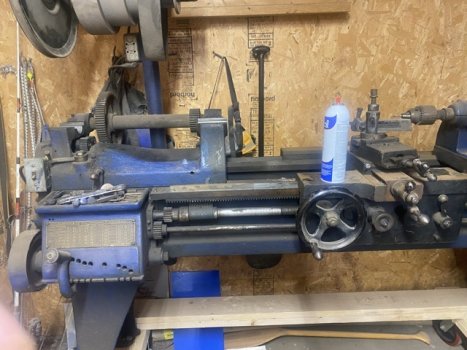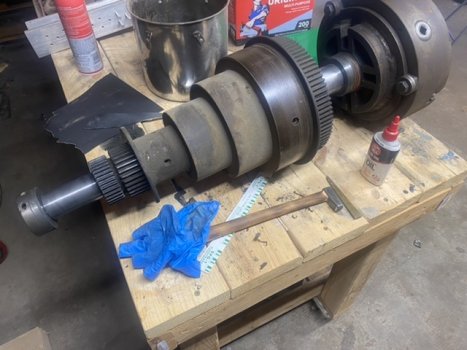You are using an out of date browser. It may not display this or other websites correctly.
You should upgrade or use an alternative browser.
You should upgrade or use an alternative browser.
Bearing replacement on old lathe
- Thread starter Edwardshandmadeknives
- Start date
Edwardshandmadeknives
Well-Known Member
I’ll have to see if I can get some Plastigage tomorrow. Definitely would make things easierIt would be good to know what clearances or tapers you've got there. Plastigage would eliminate the need to take it apart further. Just clean the surfaces well before. I have had good success using a rod or bolt (fully unscrewed) to tap on to loosen the bearing cap.
MTBob
Well-Known Member
IMHO, that's not that good. .0005 (half thousand), in an inch, perhaps. Again, depends on your application. I'd need to refer back to some old lathe books but I think striving for tolerances of +/- .0001 (one tenth of a thousandth) in a foot is more common. But... it all depends on the condition of the overall lathe, particularly the ways and carriage. There are lots of variables that can change these tolerances.if I can get .005” over an inch taper and such
Take a look at this YouTube guy that goes by Mr. Pete aka Tubalcain. He's got a ton of stuff on machine shop tools and he likes old iron, you might pick up some tips from him.
It's not too clear from the photos whether those bearings will come out, they don't look much like inserts. I'd say the babbit is poured into the bearing frame.I did try to get the bearing loose with a small hammer and a scrap aluminum chisel.
Edwardshandmadeknives
Well-Known Member
Oh, they are poured in place. I just thought they would come out easily. I’m mostly planning to use this for center drilling round bars of bronze, so I can cut them into rings I can then forge into sheath parts. I just need it better than “eyeballing” center best I can on my drill press lol! I’ll only be drilling about an inch deep. Accuracy as far as like a “real” machinist might like, isn’t really too important to me. I got it for the right priceIMHO, that's not that good. .0005 (half thousand), in an inch, perhaps. Again, depends on your application. I'd need to refer back to some old lathe books but I think striving for tolerances of +/- .0001 (one tenth of a thousandth) in a foot is more common. But... it all depends on the condition of the overall lathe, particularly the ways and carriage. There are lots of variables that can change these tolerances.
Take a look at this YouTube guy that goes by Mr. Pete aka Tubalcain. He's got a ton of stuff on machine shop tools and he likes old iron, you might pick up some tips from him.
It's not too clear from the photos whether those bearings will come out, they don't look much like inserts. I'd say the babbit is poured into the bearing frame.
Edwardshandmadeknives
Well-Known Member
I checked out his videos and subscribed. I can learn a LOT from that dude! ThanksTake a look at this YouTube guy that goes by Mr. Pete aka Tubalcain.
Edwardshandmadeknives
Well-Known Member

 Got the spindle out today, after checking the bearings with Plastigage. I don’t know what that spindle weighs, but it’s a lot. I could barely lift it. Now I gotta get to cast in place Babbitt bearings out. They are super bad lol. They are oval by about .032”. Now wonder this thing broke tooling so bad.
Got the spindle out today, after checking the bearings with Plastigage. I don’t know what that spindle weighs, but it’s a lot. I could barely lift it. Now I gotta get to cast in place Babbitt bearings out. They are super bad lol. They are oval by about .032”. Now wonder this thing broke tooling so bad.Edwardshandmadeknives
Well-Known Member
I thought about adding it but it would be so thin that I don’t think it would work well. I’ve already broken up the old ones beyond any hope of saving now, so I “have to” replace them now lolOne thing I am wondering about, although I have never tried it in the past, is just to add Babbit instead of removing and pouring new. Otherwise you have to melt it out , form and pour new, then comes the shaping and sizing. A lot of work!
MTBob
Well-Known Member
If I recall, there are companies that specialize in pouring babbit bearings. Do an InterWeb search and see if that might be a solution that's within your budget. Another "possible" option is to reassemble the bearings and line bore the existing babbit so it's oversized. In addition machine the spindle bearing surfaces to eliminate eccentric wear. It "may" be possible to then add a bronze bearing sleeve insert in the resulting gap.
Of course, there is then the age old question about whether the repair cost is worth the investment in that lathe versus buying a good used lathe in working condition.
Of course, there is then the age old question about whether the repair cost is worth the investment in that lathe versus buying a good used lathe in working condition.
Edwardshandmadeknives
Well-Known Member
This lathe, a drill press, and a bandsaw are the extent of my “machining tools”. Things like line boring, etc would all have to be hired out. I don’t even know how I would get it to a machine shop lol. I’m not doing anything that would be considered very precise, so I’m hoping to get it close. I figured out how to align the shaft and chuck with some dial indicators, so I think I can actually get it pretty decent. I’m honestly thinking about forming the bearings from .0625 bronze sheet, in two halves, then bedding each half in their bearing caps with JB Weld. I’m only running (I’m guessing) around 200 rpm, so I don’t think heat should be an issue. I did read last night that grease requires a larger bearing gap than oil to be effective, so I have to figure out if that bearing clearance will allow too much slop. I think it’s about .003 for the shaft diameter I have. I gotta read more about grease and see what I want to do.If I recall, there are companies that specialize in pouring babbit bearings. Do an InterWeb search and see if that might be a solution that's within your budget. Another "possible" option is to reassemble the bearings and line bore the existing babbit so it's oversized. In addition machine the spindle bearing surfaces to eliminate eccentric wear. It "may" be possible to then add a bronze bearing sleeve insert in the resulting gap.
Of course, there is then the age old question about whether the repair cost is worth the investment in that lathe versus buying a good used lathe in working condition.

